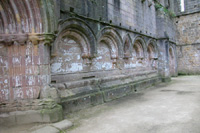 |
 |
 |
 |
 |
 |
 |
|
Fountains Abbey: History
Fountains Abbey: Buildings
|
The cloister (2/3)
The south, east and west cloister walkways essentially functioned as passageways, while the north alley was used extensively by the monks who sat on stone benches to read, meditate and perhaps also to copy manuscripts. They might even lay out their parchment here to dry.(26) In the later Middle Ages there would have been carrels or desks for the monks in the north alley.(27) The novice-master might instruct novices here and the whole community gathered in the north cloister walk for the daily Collation reading.(28) The cloister would have been warm and bright in the summer, but the monks would have found it rather bleak during the chilly winter months. When it was extremely cold they were permitted instead to read or perhaps copy manuscripts in the chapter-house. The cloister was also used for more practical activities. It was here that the monks shaved, washed themselves and their clothes, and hung the laundry to dry. Lead pipes carried water to a wall arcade outside the refectory, where pewter basins were set in recesses. This was not the original position of the wash-basins at Fountains, and geophysical survey suggests that a free-standing laver-house was in the SW corner of the cloister. Fountains was seemingly one of the first communities to use the walled lavatorium, which had bronze taps, rather than spots.(29) This sheltered location for the water-basins would have helped prevent the water from freezing over. Water was piped to the basins via a series of well-houses; Robin Hood’s well, on the south bank of the R. Skell, is the only one to have survived. The entire water system at Fountains – as elsewhere - was complex and remarkably advanced. |
